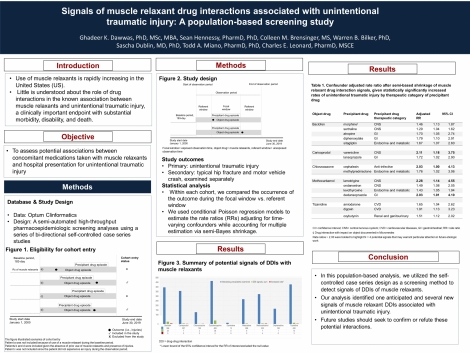Ghadeer Dawwas
Signals of muscle relaxant drug interactions associated with unintentional traumatic injury: A population-based screening study
Abstract
Objective
We examined potential associations between concomitant medications taken with muscle relaxants and hospital presentation for unintentional traumatic injury.
Methods
In a series of self-controlled case series studies, we screened 2000–2019 US Optum Clinformatics data to identify drug interaction signals for muscle relaxant + precipitant pairs and unintentional traumatic injury. We included new users of a muscle relaxant aged 16–90 years who were dispensed at least one precipitant drug and experienced an unintentional traumatic injury during continuous muscle relaxant therapy (accounting for grace periods between dispensings). We classified each observation day as precipitant-exposed or precipitant-unexposed. The outcome was an emergency department or inpatient discharge diagnosis for unintentional traumatic injury (e.g., fracture, intracranial injury). We used conditional Poisson regression to estimate rate ratios (RRs), adjusting for time-varying confounders, and accounting for multiple estimation via semi-Bayes shrinkage.
Results
We identified 74,114 new users of muscle relaxants experiencing an unintentional traumatic injury, among whom we studied concomitant use of 2,543 muscle relaxants + precipitant pairs. Sixteen (0.6%) pairs were statistically significant and positively associated with injury and therefore deemed signals of a possible drug interaction. Adjusted RRs ranged from 1.29 (95% confidence interval: 1.04–1.62) for baclofen + sertraline to 2.28 (1.14–4.55) for methocarbamol + lamotrigine. One (6.3%) of 16 signals is currently reported in a major drug interaction knowledgebase.
Conclusions
Using real-world data, we identified numerous new signals of muscle relaxant drug interactions associated with unintentional traumatic injury. Future studies should seek to confirm or refute these potential interactions.
Keywords
Muscle relaxant, unintentional traumatic injury, drug interactions, pharmacoepidemiology, population health, self-controlled case seriesCommenting is now closed.
About Us
To understand health and disease today, we need new thinking and novel science —the kind we create when multiple disciplines work together from the ground up. That is why this department has put forward a bold vision in population-health science: a single academic home for biostatistics, epidemiology and informatics.
© 2023 Trustees of the University of Pennsylvania. All rights reserved.. | Disclaimer



